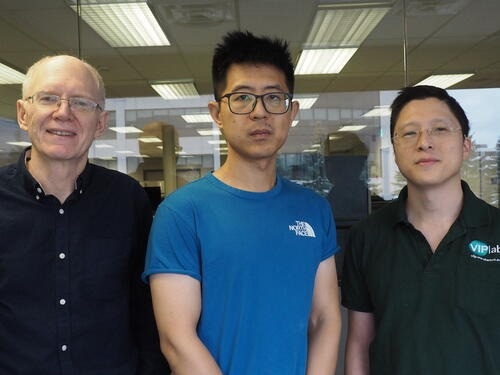An interdisciplinary team from the University of Waterloo utilizes artificial intelligence (AI) to recognize microplastics quickly and more precisely than ever before.

The PlasticNet research team (L to R): Dr Wayne Parker, Frank Zhu, and Dr Alexander Wong. Image Credit: University of Waterloo
Detecting microplastics is crucial in addressing these hazardous pollutants that not only commonly infiltrate our food but also pose significant environmental threats. Identifying their presence is fundamental to effectively eliminating them.
The research team's cutting-edge imaging identification system holds the potential to assist wastewater treatment plants and food production industries in making informed decisions. This technology could play a vital role in mitigating the potential impact of microplastics on both the environment and human health.
For a thorough risk analysis and effective action plan, precise identification based on reliable information is essential. Dr. Wayne Parker and his team sought a robust analytical tool capable of quantifying, identifying, and characterizing numerous microplastics.
Employing an advanced spectroscopy method, they exposed particles to various light wavelengths. The distinct responses generated by different plastics under this exposure act like unique fingerprints, enabling the identification of particles as either microplastic or otherwise.
One of the challenges that researchers frequently encounter is the vast range of microplastics that are produced because of fillers and manufacturing additives that can mask the "fingerprints" in a laboratory setting. This makes it challenging to distinguish between different forms of microplastics and microplastics derived from organic material. Finding nuanced patterns and cues typically requires human interaction, which is laborious and error-prone.
Microplastics are hydrophobic materials that can soak up other chemicals. Science is still evolving in terms of how bad the problem is, but it’s theoretically possible that microplastics are enhancing the accumulation of toxic substances in the food chain.
Dr. Wayne Parker, Professor, Department of Civil and Environmental Engineering, University of Waterloo
Parker reached out to Dr Alexander Wong, a Professor in the Department of Systems Design Engineering at Waterloo and the holder of the Canada Research Chair in Medical Imaging and Artificial Intelligence. His assistance allowed the team to create PlasticNet, an AI tool that allows researchers to examine vast quantities of particles 20% more accurately and about 50% faster than previous methods.
This tool represents the newest sustainable technology crafted by researchers at Waterloo. It serves as a step toward safeguarding our environment and conducting research aimed at fostering a sustainable future.
Wong notes, “We built a deep learning neural network to enhance microplastic identification from the spectroscopic signals. We trained it on data from existing literature sources and our own generated images to understand the varied make-up of microplastics and spot the differences quickly and correctly— regardless of the fingerprint quality.”
Parker's former Ph.D. Student, Frank Zhu, trialed the system using microplastics isolated from a nearby wastewater treatment facility. The outcomes demonstrated its exceptional speed and precision in identifying microplastics.
Armed with this data, treatment plants can take proactive measures to manage and eradicate these substances effectively.
Moving forward, the plan includes ongoing learning, further testing, and augmenting the PlasticNet system with additional data. This aims to enhance its microplastic identification capabilities, catering to a diverse array of requirements.
Journal Reference
Zhu, Z., et al. (2023). Leveraging deep learning for automatic recognition of microplastics (MPs) via focal plane array (FPA) micro-FT-IR imaging. Science Direct. doi.org/10.1016/j.envpol.2023.122548.